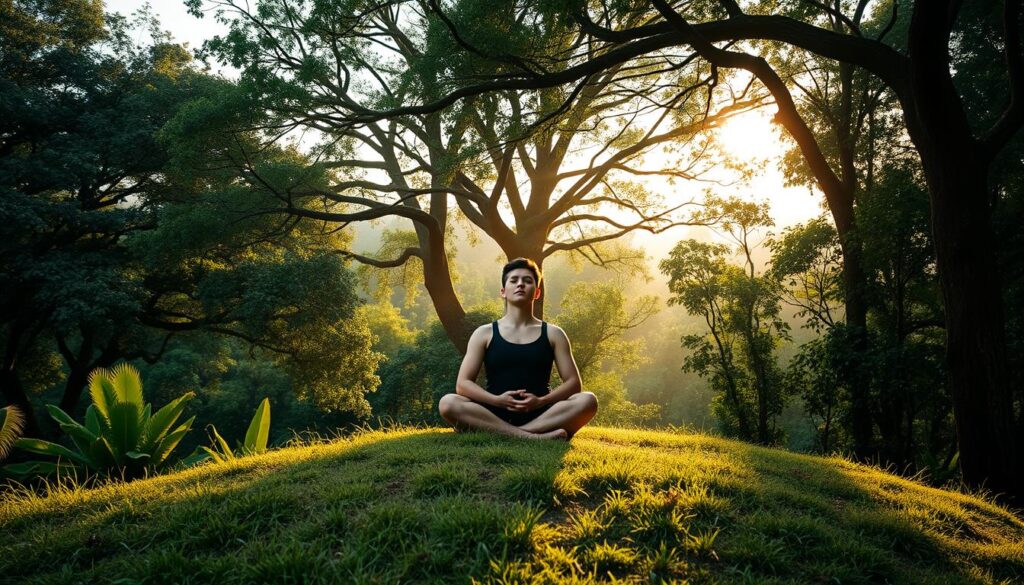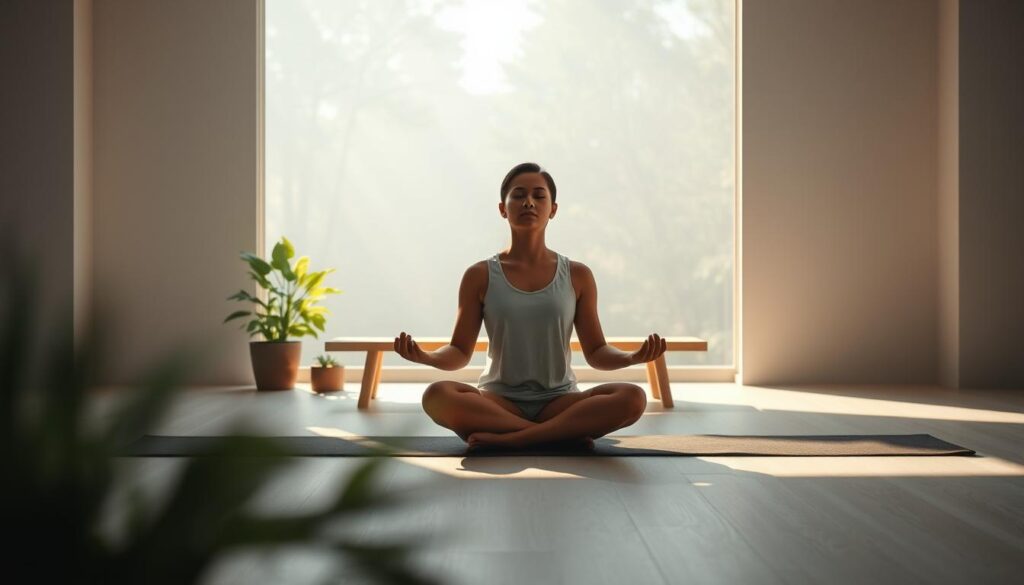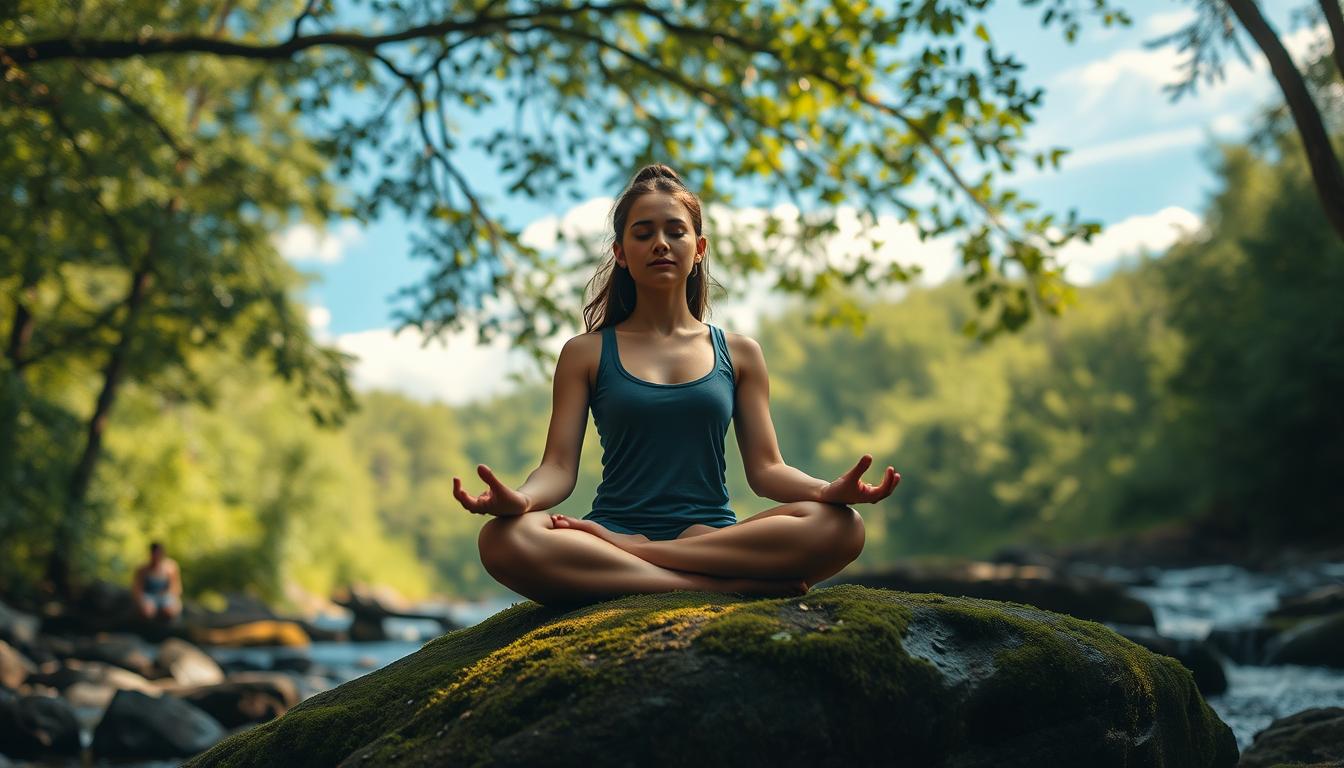I still remember the first time I tried to meditate – it was like trying to tame a wild animal
As I sat there, I realized that my mind was a constant stream of thoughts, making it hard to focus on my breath
Despite the initial struggle, I was determined to make meditation a part of my daily routine, just like taking a few minutes each day to clear my mind
As I continued to practice, I started to notice the benefits of meditation in my daily life, from reduced stress to improved mental clarity
Key Takeaways
- Understand the basics of meditation and its benefits
- Learn how to incorporate meditation into your daily routine
- Discover how to manage your thoughts and focus on your breath
- Start experiencing the positive impact of meditation on your mind and overall wellbeing
- Develop a consistent practice that fits into your busy life
What is Meditation and Why Practice It?
Meditation is often misunderstood, but it’s actually a simple yet powerful tool for transforming our lives. At its core, meditation is a practice that involves training your mind to focus, relax, and become more aware of the present moment.
Defining Meditation
Meditation is a practice that has been around for centuries, originating from various spiritual traditions. However, in the context of modern life, meditation is not necessarily tied to any specific religion or belief system. It’s about cultivating mindfulness and awareness of our thoughts, feelings, and bodily sensations. By doing so, we can gain a deeper understanding of ourselves and develop a greater sense of calm and clarity in our daily lives.
Science-Backed Benefits of Regular Practice
The benefits of regular meditation practice are backed by a growing body of scientific research. Studies have shown that consistent meditation can lead to significant changes in both mental and physical health. For instance, research by neuroscientist Amishi Jha found that just 12 minutes of meditation, 5 days a week, can protect and strengthen our ability to pay attention. Other studies have demonstrated that meditation can decrease levels of anxiety, increase immune function, and enhance overall happiness and well-being.
| Benefits | Description |
|---|---|
| Reduces Stress | Lowers cortisol levels and activates the parasympathetic nervous system |
| Improves Focus | Enhances concentration abilities through regular practice |
| Emotional Health | Reduces anxiety and depression symptoms, improving emotional resilience |
As Dan Siegel, a clinical professor of psychiatry at UCLA, once said, “The mind is like a garden, and meditation is like the gardener. You can’t just plant the seeds and expect them to grow; you need to nurture them.” This nurturing process involves regular practice, patience, and a willingness to cultivate a deeper understanding of ourselves.
By incorporating meditation into our daily routine, we can experience these benefits firsthand and improve our overall quality of life. It’s not about achieving some sort of mystical state; it’s about becoming more aware of our thoughts, emotions, and behaviors, and developing a greater sense of control over our mind.
How Can I Learn to Meditate: A Beginner’s Guide
Embarking on a meditation journey begins with understanding the simple yet powerful steps involved. If you’re looking for a resource to start your meditation practice, you’re taking the first step toward a more mindful life.

Finding a Comfortable Position
To start meditating, you’ll need to find a comfortable position, either on a chair or on a cushion on the floor. Keep your back straight but not rigid, and relax your shoulders. The goal is to be comfortable enough to remain in that position for a few minutes without feeling too much discomfort or distraction. As a meditation beginner, it’s crucial to make sure you’re physically at ease.
Focusing on Your Breath
Once you’re comfortably seated, bring your attention to your breath. Feel the sensation of the air entering and leaving your nostrils. Try to focus on the sensation of each breath without getting caught up in thoughts about it. When you find that your mind wanders (and it probably will), gently bring your attention come back to your breath. For example, you can count your breaths or focus on the sensation of the breath in your nostrils.
Working with a Wandering Mind
It’s natural for your mind to wander during meditation. When you notice that your mind has wandered, don’t criticize yourself. Instead, acknowledge the thought and gently guide your attention back to your breath. You can label the thoughts as “thinking,” “worrying,” or “planning,” and then let them go. The practice of meditation is not about achieving a state where you have no thoughts, but about becoming aware of your thoughts and gently coming back to your chosen focus, in this case, your breath. As you practice, you’ll strengthen your ability to focus and be more mindful in your daily life.
Starting Your Meditation Practice
If you’re new to meditation, getting started can seem daunting, but with a few simple steps, you can establish a consistent practice. As you begin, you’ll want to consider a few key elements to set yourself up for success.
Creating a Meditation Space
Creating a dedicated meditation space can help you establish a consistent meditation practice. This space doesn’t have to be large or elaborate; just a quiet, comfortable area where you can sit and meditate without distractions.
Choosing the Best Time to Meditate
When it comes to time, many people find that meditating at the same time every day helps to establish a consistent habit. For some, this is first thing in the morning, while for others, it’s during their lunch break or before bed. Experiment with different times to find what works best for you.
Setting a Realistic Time Commitment
When starting out, it’s essential to make a realistic time commitment. I recommend starting with just 5 minutes a day and gradually increasing the time as you become more comfortable with the practice. For example, you can start with 5 minutes, then add a minute or two each week. Consistency is more important than duration; five minutes every day is more beneficial than 30 minutes once a week.
- Start small and be consistent
- Use a timer to keep track of your meditation time
- Make meditation a part of your daily routine
- Be patient with yourself as you develop your practice
Essential Meditation Techniques for Beginners

As you start your meditation journey, it’s essential to explore simple yet effective techniques. Meditation beginners often benefit from practices that are easy to integrate into daily life. In this section, we’ll delve into three fundamental techniques that can help you establish a strong foundation for your meditation practice.
Breath Awareness Meditation
Breath awareness meditation is a foundational technique that involves focusing your attention on your breath. To practice, find a comfortable seated position, close your eyes, and bring your awareness to your breath. Notice the sensation of the air entering and leaving your nostrils, the rise and fall of your chest, or the sensation of your belly expanding and contracting. When your mind wanders, gently acknowledge the thought and return to your breath without judgment.
Body Scan Meditation
Body scan meditation is a technique that helps you cultivate awareness of your physical body. Lie down or sit comfortably, and bring your attention to different parts of your body, starting from your toes and moving up to the top of your head. Notice any sensations, tension, or relaxation in each area. This practice can help you release physical tension and promote relaxation.
Mindful Walking Meditation
Mindful walking is a meditation technique that brings awareness to your walking. Begin by walking at a natural pace, placing your hands wherever feels comfortable. You can count your steps up to 10 and then start again, or simply focus on the sensation of each step. Pay attention to the lifting and falling of your feet, the movement in your legs, and any shifting in your body. When your mind wanders, gently guide it back to the sensation of walking.
Mindful walking can be practiced anywhere, from a dedicated path in your home to a busy city sidewalk or nature trail. It’s a great way to integrate mindfulness into your daily activities, such as walking to your car or moving between rooms. By bringing awareness to your physical sensations, you can turn an ordinary walk into a meditative experience.
Common Meditation Challenges and Solutions
As we begin our meditation journey, it’s natural to experience some challenges that can be overcome with the right approach. Meditation is about non-judgmental awareness, and it’s essential to embrace whatever comes up during our practice.
Dealing with Physical Discomfort
One of the most common challenges we face during meditation is physical discomfort. We might feel restless or agitated, and our body might feel like it’s in an uncomfortable position. To deal with this, we can make some simple adjustments – we can change our posture, take a few deep breaths, or slightly adjust our position to feel more comfortable. It’s about making the practice sustainable, not about achieving some sort of physical perfection.
For example, we can use the following table to make some simple adjustments to our posture:
| Posture | Adjustment | Benefit |
|---|---|---|
| Sitting | Keep back straight | Reduce back pain |
| Legs | Keep legs relaxed | Reduce tension |
| Hands | Place hands on lap | Reduce hand tension |
Managing a Busy Mind
Another challenge we often face is managing our busy mind. Our mind might wander, and we might find ourselves caught up in thoughts or worries. When this happens, we can simply acknowledge the thought and let it go, coming back to our breath or the present moment. It’s not about stopping our thoughts completely; it’s about learning to observe them without judgment.

For instance, we can use a simple technique like noting “thinking” whenever we catch our mind wandering. This helps us to acknowledge the thought and gently come back to our meditation practice.
“Nothing’s Happening” – Managing Expectations
Some of us might feel like “nothing is happening” during our meditation practice, or that we’re not doing it “right.” We might feel bored, or we might feel like we’re not experiencing any particular insight or feeling. It’s essential to understand that meditation is not about achieving a specific state or feeling; it’s about being present with whatever is happening in the moment.
We can overcome this challenge by letting go of our expectations and focusing on the process, not the outcome. As we continue to practice, we will start to notice the benefits of meditation, like greater self-awareness and self-control, increased calm, and empathy. We have to be patient and consistent, and we will see that the benefits accumulate gradually over time.
Building a Sustainable Meditation Habit
Establishing a sustainable meditation habit requires intention, reminders, and a willingness to adapt. As you continue on your meditation journey, it’s essential to transform your practice into a consistent part of your daily life.

Creating Helpful Reminders and Cues
To make meditation a habitual part of your life, you need to create reminders and cues that trigger your practice. This could be as simple as placing a meditation cushion in a visible spot or setting a daily reminder on your phone. The key is to make these reminders consistent and meaningful, so they become a natural part of your daily routine.
For instance, you could link your meditation practice to an existing daily habit, like right after brushing your teeth or before your morning coffee. By doing so, you’re leveraging the power of association to build a new habit.
Tracking Your Progress
Tracking your meditation practice can be a powerful motivator, providing a sense of accomplishment and accountability. You can use a simple calendar mark, a meditation journal, or an app that logs your sessions. The method isn’t as important as the act of tracking itself, which helps you notice patterns and progress over time.
Beyond just logging minutes, pay attention to qualitative changes in your life, such as increased patience or better sleep quality. Recognizing these subtle shifts can be a potent reminder of the positive impact of your meditation practice, helping you stay motivated even when progress seems slow.
Conclusion: Your Journey to Mindfulness
As we finish our exploration of meditation, we can see that this practice is not just about sitting quietly; it’s about cultivating awareness and making it a part of our life.
Throughout this article, we’ve covered the essential steps to begin your meditation journey, from finding a comfortable position to managing a busy mind. We’ve also discussed the benefits of regular meditation practice, backed by science, such as improving our focus and reducing stress.
As you start or continue your meditation practice, remember that it’s not about perfection; it’s about showing up consistently and bringing kind awareness to your experience. Be gentle with yourself, and treat setbacks with compassion. With persistence, you’ll find that meditation can gradually transform your relationship with your thoughts and emotions, enhancing your overall well-being and mindfulness in daily life. Begin your journey with just one mindful breath.
## FAQ
### Q: What is the best position for meditation?
A: You can meditate in any position that is comfortable for you – sitting on a chair, on a cushion on the floor, or even on your back. The key is to maintain a posture that keeps you relaxed and alert.
### Q: How often should I meditate?
A: Start with a daily commitment, even if it’s just a few minutes – ideally at the same time each day. As you get into the habit, you can gradually increase the duration.
### Q: What should I do when my mind wanders during meditation?
A: Gently bring your focus back to your breath or the chosen meditation object. Don’t worry or be too hard on yourself – it’s a normal part of the process.
### Q: Can meditation help with anxiety?
A: Yes, meditation has been shown to help reduce anxiety by promoting relaxation and reducing stress. Regular practice can help you become more aware of your thoughts and emotions.
### Q: What are some common meditation techniques for beginners?
A: Some popular techniques include focusing on your breath, body scan meditation, and mindful walking. You can explore different methods to find what works best for you.
### Q: How long should my meditation sessions be?
A: Start with short sessions, around 5-10 minutes, and gradually increase as you become more comfortable with the practice. Even a few minutes each day can be beneficial.
### Q: Can I meditate if I’m not a “spiritual” person?
A: Absolutely – meditation is a secular practice that can be beneficial for anyone, regardless of their beliefs or background.
### Q: What are the benefits of regular meditation practice?
A: Regular meditation can lead to reduced stress, improved focus, and a greater sense of overall well-being. It can also help you become more mindful and present in your daily life.
